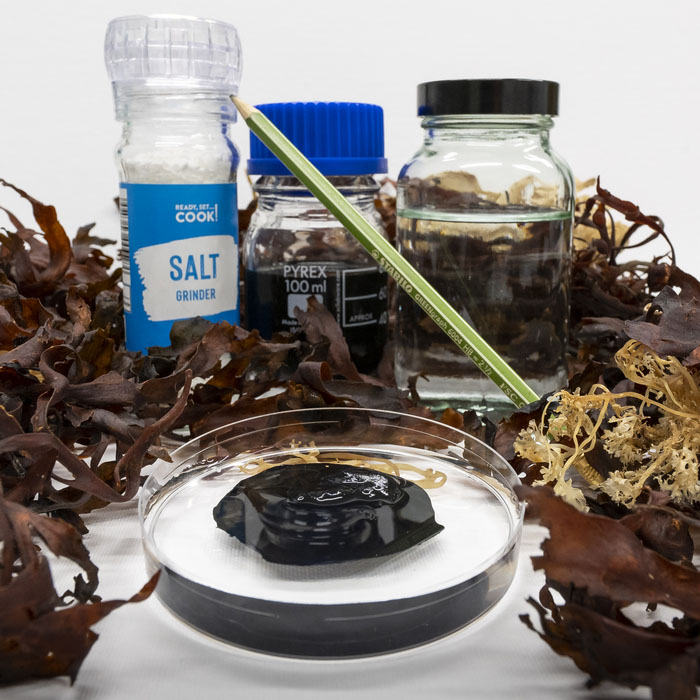| Mar 02, 2023 |
Edible graphene electronics: How a seaweed second skin could transform health and fitness sensor tech
(Nanowerk News) Scientists at the University of Sussex have successfully trialed new biodegradable health sensors that could change the way we experience personal healthcare and fitness monitoring technology (ACS Sustainable Chemistry & Engineering, "Food-Inspired, High-Sensitivity Piezoresistive Graphene Hydrogels"). |
|
The team at Sussex have developed the new health sensors – such as those worn by runners or patients to monitor heart rate and temperature – using natural elements like rock salt, water and seaweed, combined with graphene.
|
|
Because they are solely made with ingredients found in nature, the sensors are fully biodegradable, making them more environmentally friendly than commonly used rubber and plastic-based alternatives. Their natural composition also places them within the emerging scientific field of edible electronics – electronic devices that are safe for a person to consume.
|
 |
| L to R: Salt used in work in salt shaker, graphene solution, flask of water. Middle: normal pencil (to illustrate graphene in development) Front: graphene/seaweed hydrogel in water in petri dish. (Image: University of Sussex)
|
|
Better still, the researchers found that their sustainable seaweed-based sensors actually outperform existing synthetic based hydrogels and nanomaterials, used in wearable health monitors, in terms of sensitivity. Therefore, improving the accuracy, as the more sensitive a sensor, the more accurately it will record a person’s vital signs.
|
|
The idea to use seaweed in a health monitoring device was sparked when lead scientist Dr Conor Boland, a physicist at the University of Sussex, was watching TV during lockdown.
|
|
Dr Conor Boland, a materials physics lecturer in the School of Mathematical and Physical Sciences, said: “I was first inspired to use seaweed in the lab after watching MasterChef during lockdown. Seaweed, when used to thicken deserts, gives them a soft and bouncy structure – favored by vegans and vegetarians as an alternative to gelatin. It got me thinking: “what if we could do that with sensing technology?”.
|
|
“For me, one of the most exciting aspects to this development is that we have a sensor that is both fully biodegradable and highly effective. The mass production of unsustainable rubber and plastic based health technology could, ironically, pose a risk to human health through microplastics leeching into water sources as they degrade.
|
|
“As a new parent, I see it as my responsibility to ensure my research enables the realisation of a cleaner world for all our children.”
|
|
Seaweed is first and foremost an insulator, but by adding a critical amount of graphene to a seaweed mixture the scientists were able to create an electrically conductive film. When soaked in a salt bath, the film rapidly absorbs water, resulting in a soft, spongy, electrically conductive hydrogel.
|
|
The development has the potential to revolutionise health monitoring technology, as future applications of the clinical grade wearable sensors would look something like a second skin or a temporary tattoo: lightweight, easy to apply, and safe, as they are made with all natural ingredients. This would significantly improve the overall patient experience, without the need for more commonly used and potentially invasive hospital instruments, wires and leads.
|
|
Dr Sue Baxter, Director of Innovation and Business Partnerships at the University of Sussex, is excited about the potential benefits of this technology: “At the University of Sussex, we are committed to protecting the future of the planet through sustainability research, expertise and innovation. What’s so exciting about this development from Dr Conor Boland and his team is that it manages to be all at once truly sustainable, affordable, and highly effective – out-performing synthetic alternatives.
|
|
“What’s also remarkable for this stage of research – and I think this speaks to the meticulous ground-work that Dr Boland and his team put in when they created their blueprint – is that it’s more than a proof of principle development. Our Sussex scientists have created a device that has real potential for industry development into a product from which you or I could benefit in the relatively near future.”
|
|
This latest research breakthrough follows the publication of a blueprint for nanomaterial development from the Sussex scientists in 2019, which presented a method for researchers to follow in order to optimise the development of nanomaterial sensors.
|

